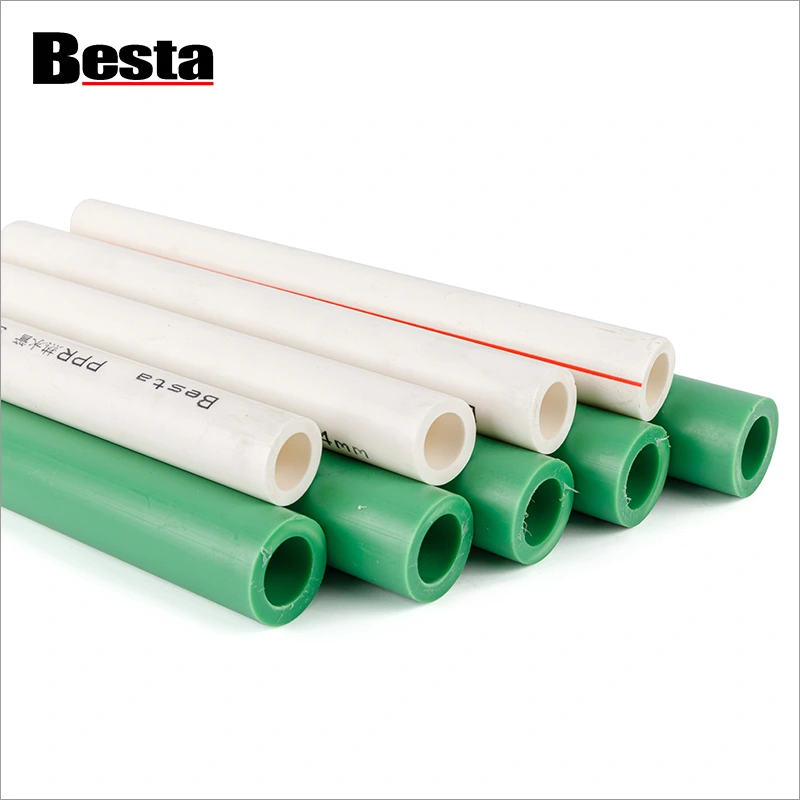- English
- Español
- Português
- русский
- Français
- 日本語
- Deutsch
- tiếng Việt
- Italiano
- Nederlands
- ภาษาไทย
- Polski
- 한국어
- Svenska
- magyar
- Malay
- বাংলা ভাষার
- Dansk
- Suomi
- हिन्दी
- Pilipino
- Türkçe
- Gaeilge
- العربية
- Indonesia
- Norsk
- تمل
- český
- ελληνικά
- український
- Javanese
- فارسی
- தமிழ்
- తెలుగు
- नेपाली
- Burmese
- български
- ລາວ
- Latine
- Қазақша
- Euskal
- Azərbaycan
- Slovenský jazyk
- Македонски
- Lietuvos
- Eesti Keel
- Română
- Slovenski
- मराठी
- Srpski језик
What are the most important considerations when selecting PPR Pipe for a specific application?
2024-10-09

What makes PPR Pipe a popular choice for plumbing?
PPR Pipe is known for its ability to withstand high temperatures and pressures without corroding or leaking. It is also resistant to chemicals and UV radiation. PPR Pipe is lightweight, flexible, and easy to install, making it a popular choice for plumbing systems in buildings.
What are the considerations when selecting PPR Pipe for specific applications?
When selecting PPR Pipe for a specific application, there are several factors to consider:
1. The size of the pipe needed for the application.
2. The temperature and pressure requirements of the system.
3. The chemical properties of the fluid being transported.
4. The physical properties of the installation site.
5. The cost of materials and installation.
What are the benefits of using PPR Pipe for hot water supply systems?
PPR Pipe is an ideal material for hot water supply systems for several reasons:
1. It can withstand high temperatures without degrading or losing its shape.
2. It is resistant to chemical corrosion from hot water and other chemicals.
3. Its smooth surface prevents sediment and rust buildup, allowing for efficient water flow.
4. Its flexible nature allows for easy installation and maneuverability in tight spaces.
What are the benefits of using PPR Pipe for cold water supply systems?
PPR Pipe is also an ideal material for cold water supply systems for several reasons:
1. It maintains its shape and strength even at low temperatures.
2. It is resistant to chemical corrosion from cold water and other chemicals.
3. Its smooth surface prevents sediment buildup and ensures efficient water flow.
4. Its flexibility allows for easy installation and maneuverability in tight spaces.
Conclusion:
PPR Pipe is a versatile and durable material that is suitable for a wide range of plumbing applications. When selecting PPR Pipe for a specific application, it is essential to consider factors such as size, temperature and pressure requirements, chemical properties, physical properties, and cost. Using PPR Pipe for hot water supply systems and cold water supply systems has many benefits, including resistance to corrosion, efficient water flow, and easy installation.
Ningbo Ouding Building Material Technology Co., Ltd. is a leading manufacturer of PPR pipes and fittings. Our products are of the highest quality and meet international standards. We are dedicated to providing our customers with the best service and products possible. Contact us at devy@albestahk.com to learn more about our products and services.
References:
1. Chen, Y., Wang, F., & Yuan, H. (2019). The application of PPR pipe in building water supply system. Chemical Engineering Transactions, 74, 685-690.
2. Kermani, M. A., & Ghadimi, A. (2015). Thermal analysis of PPR pipe for hot water supply systems. Energy Procedia, 74, 263-268.
3. Hu, R. J., Li, J. P., & Chen, H. J. (2020). Mechanical performance and fire resistance of PPR pipes under different aging states. Journal of Building Engineering, 32, 101573.
4. Sun, L., & Li, H. (2017). The development of PPR water supply pipe. Plastic Science and Technology, 45(7), 154-157.
5. Zhang, Y., Zhang, J., & Zhang, Y. (2018). Mechanical behavior and creep damage modeling of PPR pipes under long-term hydrostatic pressure. Polymer Testing, 66, 1-9.
6. Chen, J., Xu, D., & Li, F. (2019). Research on the anti-aging performance of PPR pipe in building water supply system. IOP Conference Series: Materials Science and Engineering, 709, 022058.
7. Zhang, J., Liu, X., & Jiang, X. (2018). Study on thermal conductivity of PPR pipe for hot water supply system. IOP Conference Series: Materials Science and Engineering, 456, 042018.
8. Liu, X., Zhang, J., & Jiang, X. (2020). Experimental study of PPR pipe for hot water supply system under thermal cycling. Energy Procedia, 170, 559-564.
9. Li, S., & Zou, C. (2017). Optimal thickness design of PPR pipes for hot water supply system based on the real-time measurement of wall temperature. Applied Thermal Engineering, 112, 33-40.
10. Al-Qallaf, B., & Al-Ali, A. (2015). Probabilistic life cycle cost analysis of PPR and copper piping systems in Kuwait. Journal of Construction Engineering and Management, 141(10), 04015020.




